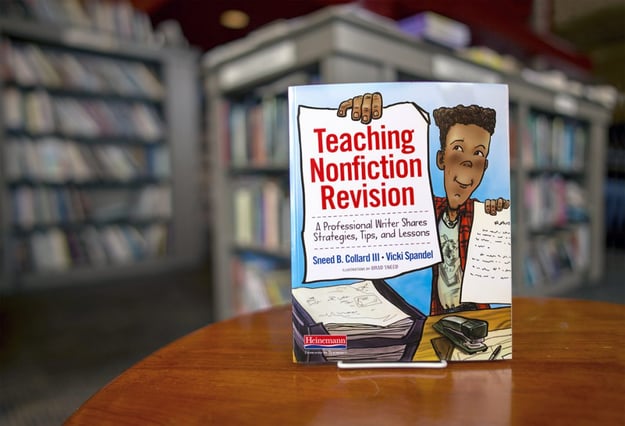
Adapted from Teaching Nonfiction Revision: A Professional Writer Shares Strategies, Tips, and Lessons by Sneed B. Collard and Vicki Spandel
Have you ever watched a film that you enjoyed, but afterward had trouble describing— or, worse yet, never thought about again? Unfortunately, many Hollywood movies fall into this category.
They seem well-constructed and crackle with gee-whiz action, yet leave the audience empty and disappointed. Most often, the problem boils down to one issue: there’s no person or thing in the movie that we actually care about. Instead of being character driven, these movies are plot-driven. They are defined by events instead of characters that we actually identify with.
Character-driven movies and books are almost always more engaging than their plot driven counterparts. Even if you’re an action movie fan, it’s almost guaranteed that you will enjoy an action film with complex, well-rounded characters more than one populated by cardboard stereotypes. This is as true for nonfiction as it is for fiction. The next time you’re in a bookstore, take a look at the nonfiction shelves. You’ll see that most of the best-selling books are biographies or memoirs. That’s no accident. People love reading about other peoples’ lives. We want to learn about their passions and experiences. Mostly, we want to learn about their struggles and how they did or didn’t overcome them.
That doesn’t mean that all nonfiction manuscripts have to be about people. Characters can be almost anything—places, events, buildings, animals. And a writer doesn’t have to stick to just one character. Most nonfiction books switch between a number of different characters to tell a story.
In order to hold readers’ attentions, therefore, writers have to make sure characters engage readers right off the bat. Following are some strategies writers use to make readers care about our nonfiction characters.
- Introduce the character in a surprise setting: This creates a curiosity in readers, making them want to find out more.
- Place the character in a hopeless situation: This makes a reader care about and root for your character
- Establish a character through a memorable anecdote: this helps readers identify with a character’s specific traits and decisions.
- Present a character as a foe or challenge
- Show a character in opposition to another
As a way of reviewing these five strategies, see if students can identify which of the five—and there could be more than one—each of the following authors is using:
- Jon Scieszka’s memoir Knucklehead (2008) is filled with recollections of treehouses and raccoon hunts, broken collarbones resulting from an invented game called “Slaughterball,” awkward moments spent attending a school where his father was principal, and other tales about growing up as one of six brothers.
- In Extreme Animals (2006), author Nicola Davies takes readers from the frozen Arctic to the lethal heat of the desert to show how bears, frogs, camels, Arctic musk oxen and other impressive creatures endure conditions most of us could never survive.
- In Case Closed? (2013), author Susan Hughes pits an eighteen-foot bamboo raft against weather, insects, and the ocean itself to see if it can make the 7,500- mile journey from Hong Kong to Japan to America.
- In Laura Hillenbrand’s Seabiscuit (2001), the fabled thoroughbred meets his nemesis—the legendary, Triple Crown winner War Admiral—in a grueling match race “still widely regarded as the greatest horse race in history” (264).
- In his memoir The Boy on the Wooden Box (2013), author Leon Leyson recounts his struggle to survive in a German concentration camp: “My first impression of Plaszów as hell on earth never changed” (113).
After reviewing these five strategies, have students go through their own drafts, choosing one character to focus on, then asking, “How can I make readers care more about this character?” Give them time to revise, using one or more of Sneed’s five strategies.

 One of today’s favorite nonfiction children’s authors, Sneed B. Collard III has written more than 80 books, ranging from captivating picture books to middle-grade novels to award-winning science books. He is the 2006 recipient of the Washington Post Children’s Book Guild Nonfiction Award for his body of work. To learn more about Sneed, his books, and speaking activities, visit www.sneedbcollardiii.com.
One of today’s favorite nonfiction children’s authors, Sneed B. Collard III has written more than 80 books, ranging from captivating picture books to middle-grade novels to award-winning science books. He is the 2006 recipient of the Washington Post Children’s Book Guild Nonfiction Award for his body of work. To learn more about Sneed, his books, and speaking activities, visit www.sneedbcollardiii.com.
 Vicki Spandel has spent her professional life working with students and teachers of writing—as a classroom instructor, online writing coach, journalist, editor, technical writer, and curriculum developer. She is the author of multiple books on writing, including Creating Writers, Creating Young Writers, and The 9 Rights of Every Writer. Visit Vicki online at http://sixtraitgurus.wordpress.com to see writing lessons based on contemporary literature.
Vicki Spandel has spent her professional life working with students and teachers of writing—as a classroom instructor, online writing coach, journalist, editor, technical writer, and curriculum developer. She is the author of multiple books on writing, including Creating Writers, Creating Young Writers, and The 9 Rights of Every Writer. Visit Vicki online at http://sixtraitgurus.wordpress.com to see writing lessons based on contemporary literature.


